Night Owls Retrospective
VM Retrospective - October 2024
Prior to Night Owls, I decided to swing big by laying the foundations for an independent game studio focused on short yet psychologically complex narrative games. Vine Moss Games was designed with the intention of delivering unique interactive projects with story and characters that could be defined as literary - a term given to novels that prioritize and study characters over a well-structured and defined plot. With this vision in mind, this past month I set out on creating a psychologically complex thriller story that utilized unconventional approaches to visual and text-based narrative. I wanted this project to be a litmus test for the kinds of interactive games I wanted to design, both in terms of how players reacted to the final game and how efficient my current development process is. I decided to join several spooky-themed jams in the process to motivate me and get crucial feedback on my intention and submitted project. With October over and Night Owls in the world, here were the 5 rights and 5 wrongs that made this process possible and fruitful.
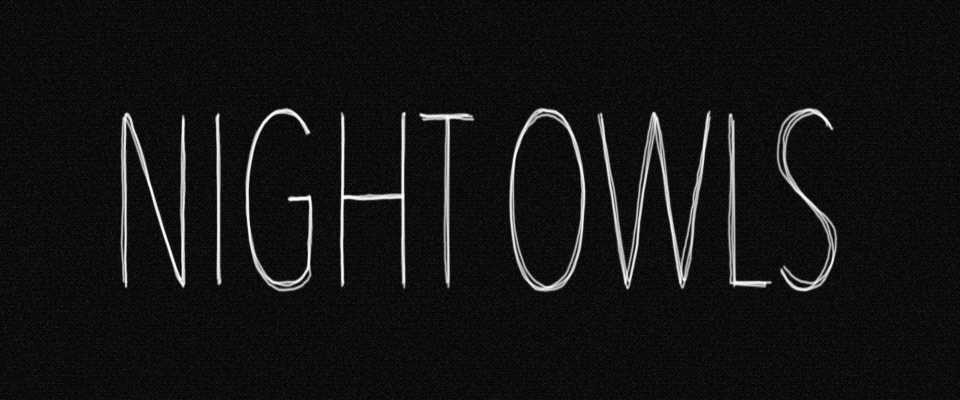
5 Rights
Drafting the Story in Twine
Several of my projects in the past have explored characters’ relationships with one another through the lens of social media and the internet as a whole, and I decided to revisit this idea through the lens of a character chatting with an online stranger. There’s something unnerving about communicating with someone online, especially when there’s no way to know the true identity of the person on the other side of the computer screen.
Settled on this idea, I began writing out character profiles, writing potential scenes, and outlining big narrative arcs I wanted to accomplish in this narrative – all within Twine, a game tool designed primarily for text-based interactive stories with branching choices. Twine has always been a great prototyping tool for me since I can write out different scenes, loosely design what the big choices in the game would be, and quickly play test the story without having to create any of the other elements for the game. I always treat it as writing and testing the script before filming to reduce wasted work. This way of writing and planning has consistently been an effective method for me when designing my narrative games, and that was certainly the case for Night Owls.
Establishing Art Direction through Mood Boarding
Believe it or not, a lot of my game ideas start from seeing a post online, usually a unique artwork or animation, and wondering how that could work in an interactive medium. The aesthetic of Night Owls was largely inspired by noir films stills, shaky black-and-white line art, and a myriad of unsettling artwork found on Pinterest! Through collecting different posts of eerie work, as well as a few posts that used comic-like panels, I had a strong sense of what Night Owls could look like and how the visuals could act like a narrative vehicle in a way that challenges the typical visual novel format.
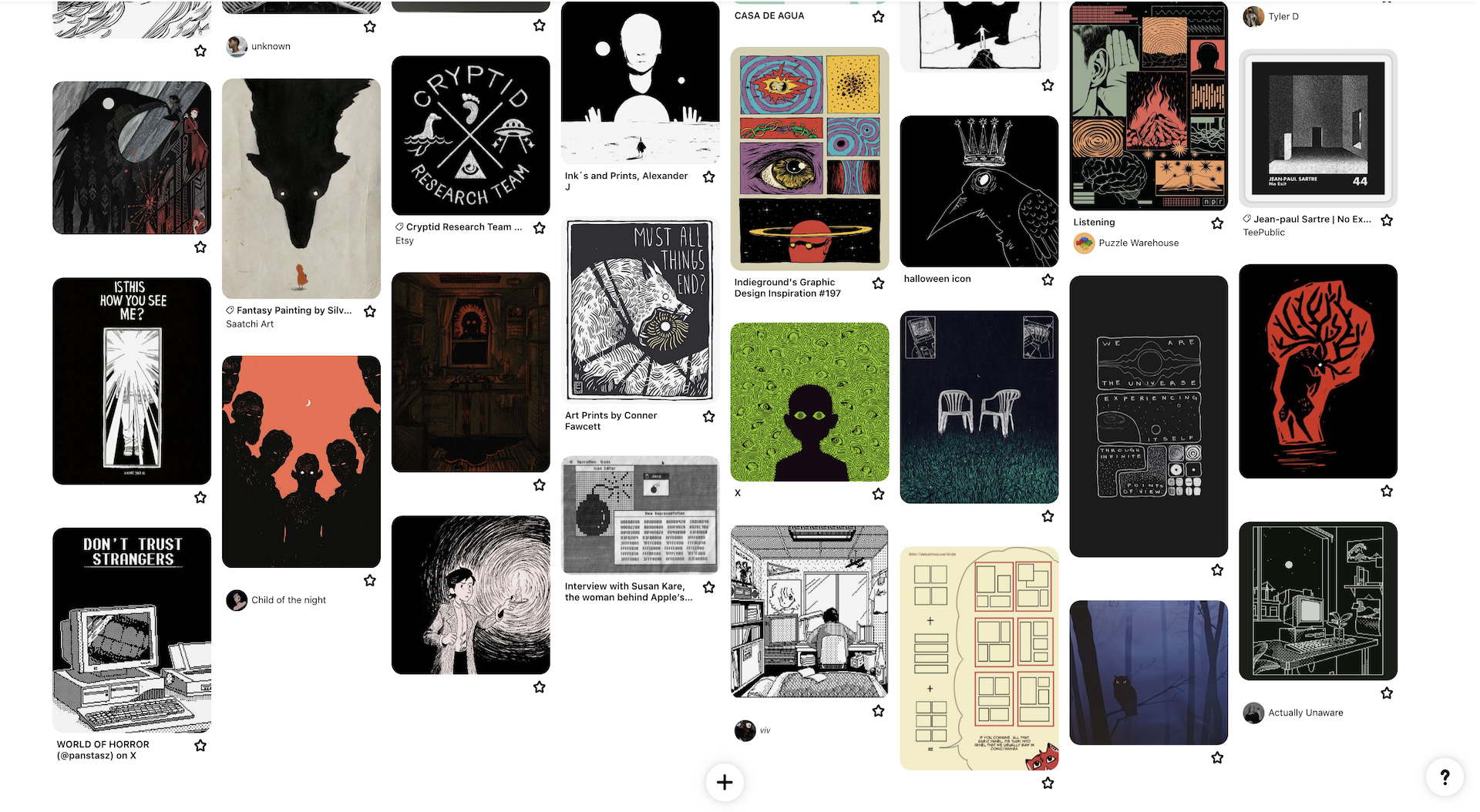
Multiple Viewpoints for Text
In another attempt to challenge the traditional visual novel format - with text only at the bottom of the screen as visuals change - I wanted to challenge myself by having different panels represent different modes of communication. This resulted in designing panels for text messages and for Serenity’s internal thoughts. I thought this would not only be a unique way of experiencing the story, but also would help players clearly distinguish text as things written on computer, things sent via text, and things Serenity says to herself. This felt like an innovative way to challenge the common format of the visual novel, while still ensuring narrative clarity for the player.
Procreate Drawing and Animations
I do most of the visual art for my games in Procreate and Procreate Dreams, tools I’ve learned over the past couple of years that have reduced the barrier to art and design for someone with a non-traditional art background. Designing the panels required drawing the panels at least 4 different times and creating an animation that excluded 1 of the drawings over 4 frames. This created the boiling effect that added more appeal to the overall design, but it also represented the anxiety and instability I wanted to convey for Serenity throughout the night.
My favorite part of the visual process was working on the hand typing animations using Procreate Dreams. I morphed and resized the hands over a timeline animation to create a smooth (and personally unsettling) animation for whenever Serenity typed on her keyboard or sent a text to Connor. While the animation is subtle, I really love how it turned out for the project.
Translating Vision into Execution
I’m pleased with how this project aligned with what I had in mind from the very beginning. I was interested in creating line art panels that shifted in and out of view as the story progressed, and I was happy to develop something that captured that visual direction. The way I scoped this project; the constraints I outlined for visual art, narrative, and gameplay; and the understanding of my own developmental skill set; contributed to accomplishing the goals I set out for Night Owls.
5 Wrongs
Dialogue Manager Headache
Before this project, I hadn’t really created a text-heavy game in Godot, so I wasn’t entirely sure how to translate my work from Twine into Godot in a way that was clear and appealing. I was part of a team that used the plugin Dialogue Manager to prototype a previous Godot project, and decided that it would be the easiest thing to learn and implement for my game within a month's time frame.
Overall, I still agree with that decision, as Dialogue Manager is a simple, easy-to-learn plug-in for visual novels. However, I had a lot of hurdles trying to translate what I wanted and detailed in the Twine prototyped into Godot and Dialogue Manager because of how unfamiliar I was with the plugin’s innerworkings. Two of the biggest challenges were deciding how to move the different panels as the narrative progressed and how to display the different types of text in the three different panels. After a series of failed attempts, youtube videos, and experimentation, I decided that the solution to both of these challenges was signals. Within the Dialogue Manager script for all the text in the game, I could send a signal that would essentially tell my game to pull a specific panel with a specific image in and out of view. Likewise, I could send a signal that told the game to pull the text message or internal thoughts panel into view with a specific message that I had written to be sent with the signal.
While this solved a lot of the problems I was having with displaying text and applying “stage directions” in the game, this resulted in a more finicky system that required a lot of work to design.
Developing a System that was Too Specific
I had a finicky system that required a lot of work to design. This meant that every frame pulled in and out of view, the timing between text and images, the sound queues and cutoffs, and several other subtle actions in the game, were all implemented manually. This was the biggest hurdle during development because I would obsess over the right amount of seconds to display each panel, and I had to playtest scenes several times in a row to get it right. This felt like making a more complicated short film in this way: instead of telling actors to reset and redo a scene, I had to go into the script and manually adjust the characters and scenes until I was satisfied with how it appeared on the screen.
Even after a lot of hours devoted to adjustments, I was still left with plenty of timing errors that resulted in messages advancing too quickly for a player and the story getting lost. Had I understood Dialogue Manager more, or had a better way to pause text that wasn’t controlled by Dialogue Manager, I would have given players the option to advance all texts that appeared whenever they wished to advance. This would have drastically reduced the amount of time I spent writing out wait (x seconds) after every line of dialogue.
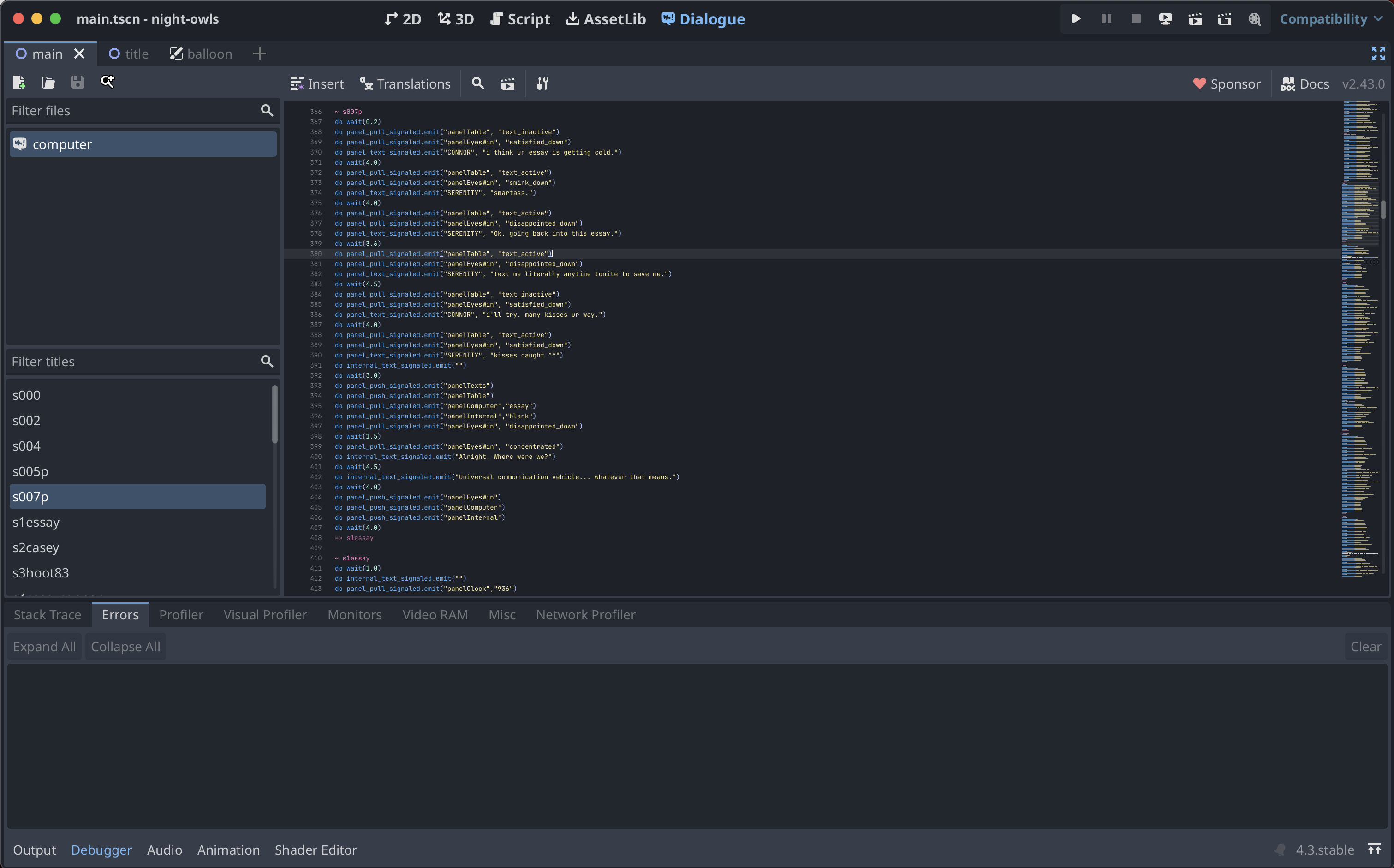
Web Export Disappointment
For most of my games, I usually create a playable web build that makes it easy for potential players to play my game without needing to download anything. Since my games are usually short enough to upload to itch without problems, I thought Night Owls would benefit from a web build, especially with the number of game jams I was participating in.
However, as I finished my first version of the game, created a web build, and tested it on itch, I was extremely confused to see the web build not working. After some online research and panicked reuploads, I found out that this was a result of a bug in Godot 4.3 related to using audio buses. Despite attempting to create workarounds for this project, building in a 4.4 development version of Godot, and redoing parts of the project to try and resolve this issue, I was still left with an unplayable web build. While this specific bug has been address by Godot developers and will be patched in the full 4.4 release, I was still disappointed in not having a web build playable for the jam.
Not Providing Weekly Updates for Myself!
Before I started any work on this project, I was determined to plan out what tasks I had for the month. This included creating weekly development logs that outlined what I accomplished for the week, what were some of my struggles, and what I planned for the next week. I wanted to have these as a proper way to document my progress through the month, as well as use it as notes for this very retrospective that I’m writing now. When I really got into the development flow of this game, however, I didn’t prioritize writing up a weekly devlog. While this didn’t derail the project in any way, I now have a harder time remembering how I felt during different moments of the development process.
I also plan on posting devlogs and updates somewhat regularly for future Vine Moss Games, and I should have practiced this during this game in order to get a better sense of how these write-ups would fit in my schedule and inform my relatively quick development process.
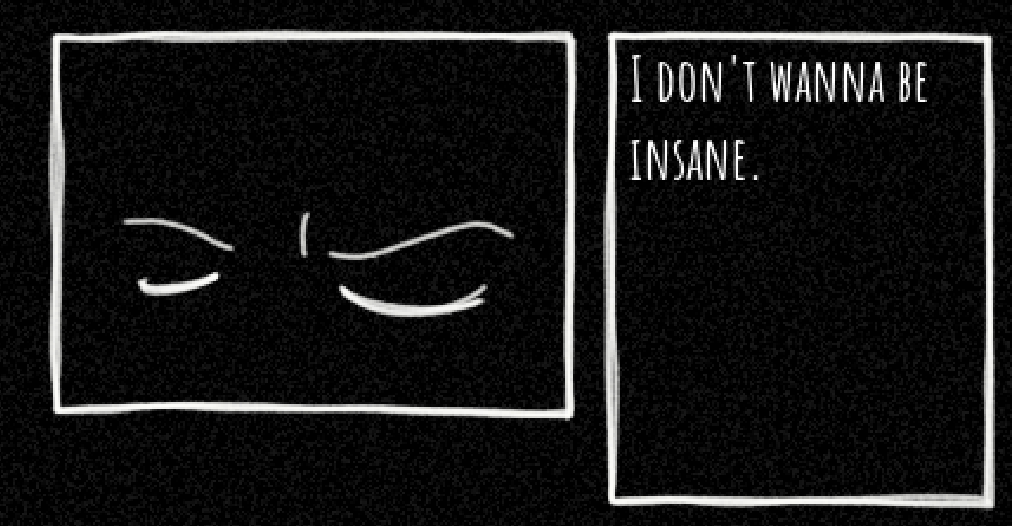
Structure of Overall Process was Too Loose
As I look back on this past month, there were plenty of moments where I was developing simply to “make the game.” I didn’t create and adhere to many milestones during this process, which I believe made the entire process more stressful and intensive than it needed to be. While I didn’t feel burnt out or overwhelmed in any way, I do think having strict weekly goals would put me in a good position to be able to create these types of games without overworking myself. Going from ideation and pre-production to full development to post-production and playtesting with clearer milestones and structures in place will be a huge benefit for me and for my work.
What’s Packed For The Horizon
Night Owls is the first game developed under the Vine Moss Games umbrella, and I’m extremely proud of the initiative taken and work done to release this project into the world. As I add the final touches to Night Owls and ponder my development process, there are a number of key takeaways. I intend to keep the way I brainstorm and establish my art direction for my games, largely through moodboarding until I have a strong vision for what a particular game could look like. Since many of my games will involve text and displaying conversations in unique ways, I would like to spend time learning more methods for dialogue, with the hope of building my own dialogue system for my needs. In terms of documentation and production process, I know I have to be more honest with myself when it comes to what is achievable on a weekly basis, as well as make sure I’m dedicating time to writing up retrospectives like this throughout the development cycle. Finally, while I am pleased with the innovative techniques I implemented in Night Owls, I am working to challenge myself even more and be more experimental in the work I design. I have faith and confidence in Vine Moss Games and it’s intent on delivering literary games, and I want to constantly reimagine what literary games mean and what they can look like.
That said, there are several game ideas in the tank for Vine Moss Games, and I’m incredibly excited to bring them to life and share my growth with every project. While this long retrospective is mainly for me, I appreciate those who’ve taken the time to read and play Night Owls. I hope you’ve come away with new insight in my process, and I’m extremely thankful for your time and interest in Vine Moss Games!
~ Dev
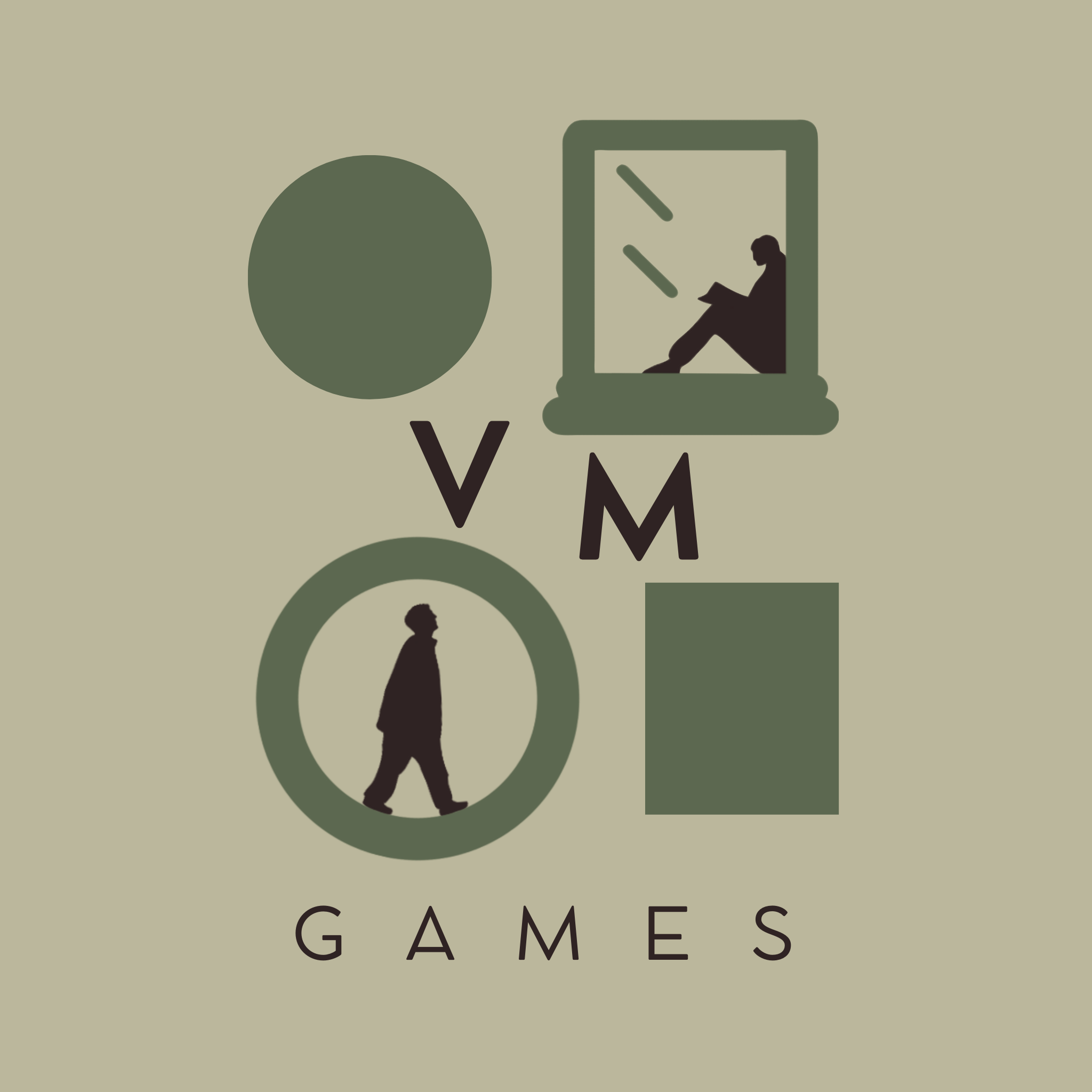
Get Night Owls
Night Owls
A ~20 min unsettling narrative that marks the 20-year anniversary of the disappearance of a 20-year-old woman.
| Status | Released |
| Authors | Vine Moss Games, Devinne |
| Genre | Visual Novel |
| Tags | 2D, Atmospheric, Godot, Horror, Indie, Narrative, Psychological Horror, Short, Spooky |
More posts
- Night Owls 1.0 Release NotesNov 26, 2024
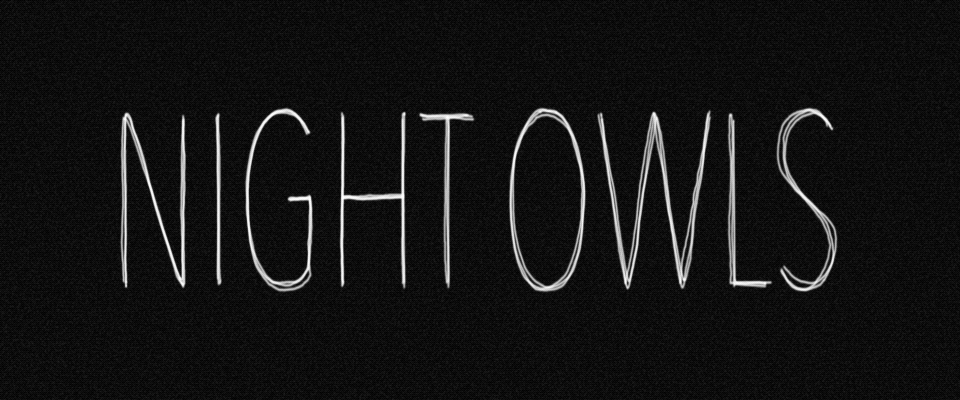
Comments
Log in with itch.io to leave a comment.
When did you start work on this?
Thanks for asking! I started art mood boarding, ideating, and learning the Dialogue systems I wanted to use during the first two weeks of October. in-engine development for Night Owls started after all the jams I intended on submitting to opened up and themes were announced!
It is a very good game, extremely powerful. I saw that this qualified for a variety of jams.
Your dev log was also excellent.
My sense is that you are a consummate professional who would not violate the terms of a jam regarding the start date.
Am I correct?
It's so much easier to just ask. :-)
Thank you so much for the compliments! Yes absolutely - my intention with this project was to act with good faith for the jams I submitted to by waiting until all started before in-engine development, especially as I'm working towards building Vine Moss Games as a professional narrative studio. I appreciate you being upfront with asking!